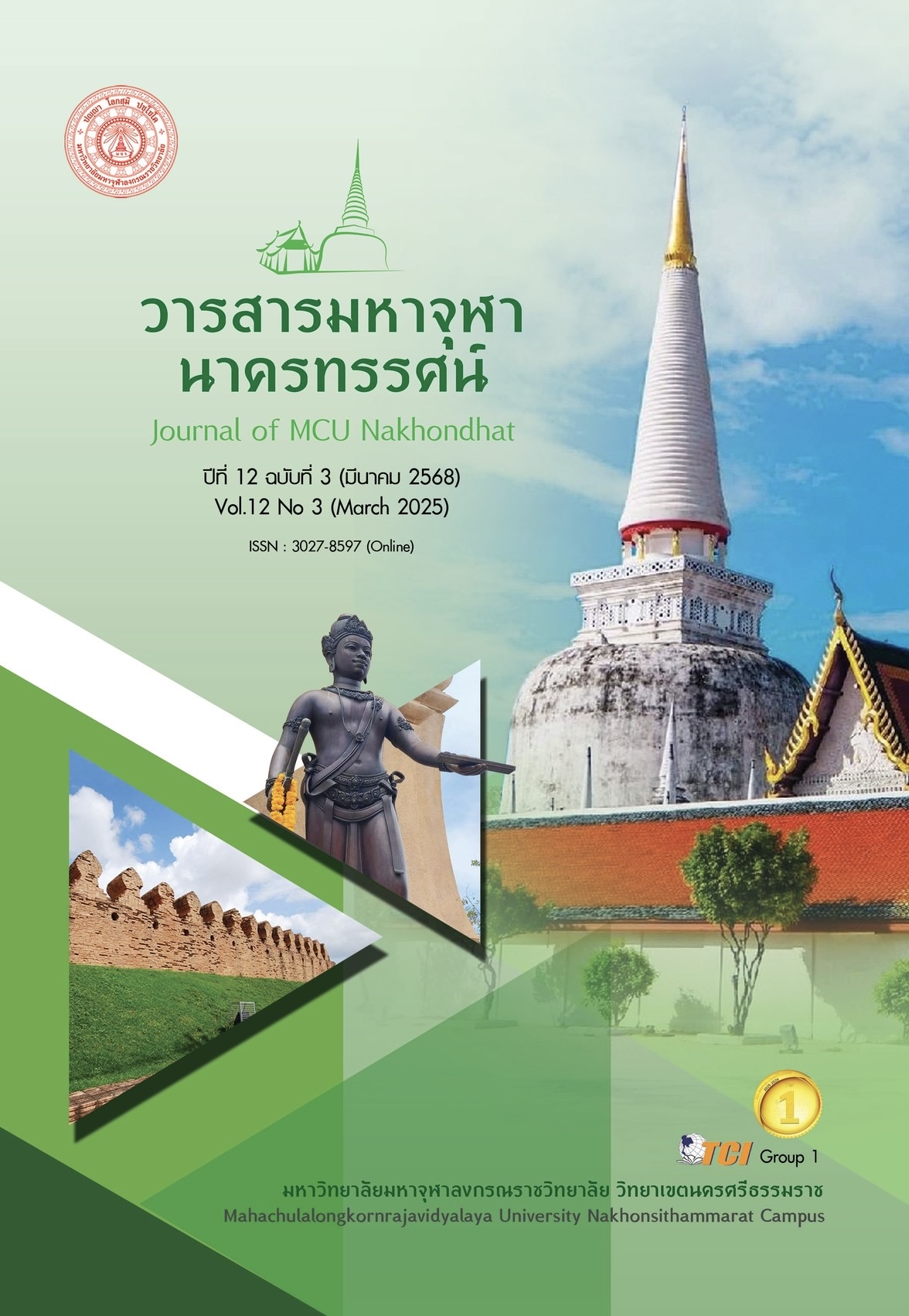OPERATIONAL EFFECTIVENESS OF COMMUNITY FINANCIAL INSTITUTIONS IN THE NORTHERN PROVINCES
Main Article Content
Abstract
This research aims to: 1) Examine the significance of social capital, member participation, leadership, management, and operational effectiveness of community financial institutions; 2) Analyze the factors influencing the operational effectiveness of community financial institutions; and 3) Explore strategies for improving the operations of community financial institutions in the northern provincial cluster. A mixed-methods research approach was employed. The research tools include: 1) A questionnaire survey of 400 community financial institution executives or committee members, selected through simple random sampling; and 2) In-depth interviews and focus group discussions involving 12 and 6 participants, respectively. The key informants consisted of community financial institution committee members, academics, and financial institution experts, selected through purposive sampling. The findings revealed that social capital, member participation, management, and operational effectiveness were all rated at a high level, while leadership was rated at the highest level. Multiple regression analysis indicated that social capital, member participation, and management could predict 61.20% (R² = .612) of the operational effectiveness of community financial institution in the northern provinces, with statistical significance at the 0.01 level. When ranking the factors influencing operational effectiveness, social capital had the highest impact, followed by management and member participation, respectively. Strategies for enhancing village and urban community funds should begin with promoting the local economy to foster self-reliance among members and ensure a stable income. Approach to improv operational effectiveness should include activities that strengthen social capital, encourage member participation, integrate technology, and ensure the selection of knowledge, competent, and ethical committee members who can manage operations with transparency.
Article Details

This work is licensed under a Creative Commons Attribution-NonCommercial-NoDerivatives 4.0 International License.
References
กรวีร์ ปัณณราช และฏฐภัทร์ ศุภเศรษฐสิริ. (2567). แจงสี่เบี้ย. เรียกใช้เมื่อ 16 เมษายน 2567 จาก https://www.bot.or.th/content/dam/bot/documents/th/research-and-publications-pdf/articles-and-publications/articles/download/2024/article-2024mar06.pdf
ชุติมณฑน์ วงษ์คำหาร. (2559). ความสำเร็จในการนำนโยบายการยกระดับกองทุนหมู่บ้านเป็นสถาบันการเงินชุมชนไปปฏิบัติ: กรณีศึกษา สถาบันการเงินชุมชนปากเกร็ดร่วมใจ 2. ใน วิทยานิพนธ์รัฐศาสตรมหาบัณฑิต สาขาวิชาการเมืองการปกครอง. มหาวิทยาลัยธรรมศาสตร์.
ณฐชน วงษ์ขำ. (2561). ปัจจัยสู่ความสำเร็จของการนำนโยบายกองทุนหมู่บ้านไปปฏิบัติ: กรณีศึกษากองทุนที่ได้รับการพัฒนาเป็นสถาบันการเงินชุมชนในจังหวัดสมุทรปราการ. ใน วิทยานิพนธ์รัฐประศาสนศาสตรมหาบัณฑิต สาขาวิชารัฐประศาสนศาสตร์. สถาบันบัณฑิตพัฒนบริหารศาสตร์.
บุญธรรม กิจปรีดาบริสุทธิ์. (2549). สถิติวิเคราะห์เพื่อการวิจัย. (พิมพ์ครั้งที่ 4). กรุงเทพมหานคร: จามจุรี โปรดักท์.
ปิยะวดี ยอดนา. (2561). การบริหารแบบบูรณาการของสถาบันการจัดการเงินทุนชุมชนจังหวัดสกลนคร. ใน วิทยานิพนธ์ปรัชญาดุษฎีบัณฑิต สาขาวิชาการบริหารการพัฒนา. มหาวิทยาลัยราชภัฏสกลนคร.
พระปุญญาพัฒน์ แสงวงค์ดี และกฤตวรรณ สาหร่าย. (2565). ปัจจัยสู่ความสำเร็จสถาบันการเงินชุมชนบ้านดอน ตำบลโป่งน้ำร้อน อำเภอฝาง จังหวัดเชียงใหม่ และสถาบันการเงินชุมชนบ้านแม่ใจใต้ ตำบลเวียง อำเภอฝาง จังหวัดเชียงใหม่. วารสาร มจร การพัฒนาสังคม, 7(1), 117-193.
ศิริชัย กาญจนวาสี. (2556). ทฤษฎีการทดสอบแบบดั้งเดิม. (พิมพ์ครั้งที่ 2). กรุงเทพมหานคร: โรงพิมพ์แห่งจุฬาลงกรณ์ มหาวิทยาลัย.
สำนักงานกองทุนหมู่บ้านและชุมชนเมืองแห่งชาติ. (2567). รายงานสรุปจำนวนสถาบันการเงินชุมชน สาขา 1 และ 2. กรุงเทพมหานคร: สำนักงานกองทุนหมู่บ้านและชุมชนเมืองแห่งชาติ.
สำนักงานการตรวจเงินแผ่นดิน. (2561). กองทุนหมู่บ้านและชุมชนเมืองแห่งชาติ. เรียกใช้เมื่อ 20 มกราคม 2566 จาก https://www.audit.go.th/th/กองทุนหมู่บ้านและชุมชนเมืองแห่งชาติ-สำนักงานกองทุนหมู่บ้านและชุมชนเมืองแห่งชาติ
สำราญ วิเศษพรม. (2560). รูปแบบพัฒนาการบริการจัดการสถาบันการเงินชุมชนในจังหวัดนครพนม. ใน วิทยานิพนธ์รัฐประศาสนศาสตรดุษฎีบัณฑิต สาขาวิชารัฐประศาสนศาสตร์. มหาวิทยาลัยราชภัฏมหาสารคาม.
สุจิตรา บุณยรัตพันธุ์. (2557). ระเบียบวิธีวิจัยสำหรับรัฐประศาสนศาสตร์. (พิมพ์ครั้งที่ 14). กรุงเทพมหานคร: พับลิชชิ่ง.
สุภางค์ จันทวานิช. (2547). วิธีการวิจัยเชิงคุณภาพ. (พิมพ์ครั้งที่ 12). กรุงเทพมหานคร: สำนักพิมพ์แห่งจุฬาลงกรณ์มหาวิทยาลัย.
อุมาวดี เดชธำรงค์ และวิระพงศ์ จันทร์สนาม. (2562). ปัจจัยแห่งความสำเร็จในการพัฒนาเศรษฐกิจชุมชน: กรณีศึกษา สถาบันการเงินชุมชนในจังหวัดชัยภูมิ. วารสารสมาคมนักวิจัย, 25(1), 72-89.
Best, J. W. (1997). Research in Education. (3th ed.). Englewood Cliffs, New Jersey: Prentice Hall, Inc.
David, A. S. et al. (2023). Mediating Effect of Public Participation on the Relationship between Budgeting Practices and Financial Performance of County Governments in Kenya. Stratford Peer Reviewed Journals and Book Publishing Journal of Finance and Accounting, 7(5), 78-94.
Dilshad, R. M. & Latif, M. I. (2013). Focus Group Interview as a Tool for Qualitative Research: An Analysis. Pakistan Journal of Social Sciences, 33(1), 191-198.
Hair, J. F. et al. (2010). Multivariate data analysis. (7th ed.). Upper Saddle River, New Jersey: Prentice Hall.
Kerr, S. & Jermier, J. M. (1978). Substitutes for leadership: Their meaning and measurement. Organizational Behavior and Human Performance, 22(3), 375-403.
Pedhazur, E. J. (1997). Multiple Regression in Behavioral Research. New York: Holt Rinehart and Winston.
Putu, Y. W. et al. (2019). Social Capital Effectiveness toward Competitive Advantage and Business Performance (Case Study of Village Credit Institutions in Gianyar Regency, Bali, Indonesia). Scientific Papers Series “Management, Economic Engineering in Agriculture and Rural Development”, 19(3), 2285-3952.

